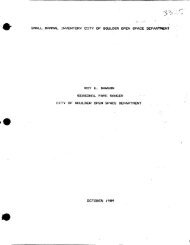Suzy Ageton George Karakehian KC Becker Tim ... - City of Boulder
Suzy Ageton George Karakehian KC Becker Tim ... - City of Boulder
Suzy Ageton George Karakehian KC Becker Tim ... - City of Boulder
You also want an ePaper? Increase the reach of your titles
YUMPU automatically turns print PDFs into web optimized ePapers that Google loves.
FAA Issues with RTTF: The FAA has a history <strong>of</strong> concerns about airports with RTTFs<br />
because <strong>of</strong> the safety issues related to airplanes traversing airport property outside <strong>of</strong><br />
approved taxiways. Since 1989, the FAA has strongly discouraged RTTFs. In 2009, it<br />
determined that all RTTFs should be eliminated due to widespread compliance issues.<br />
There was an outcry by users <strong>of</strong> airports where RTTFs used established taxiways and<br />
believed they should not be regulated because <strong>of</strong> RTTFs that created dangerous access<br />
routes to an airport. The proponents <strong>of</strong> RTTFs worked with members <strong>of</strong> Congress to<br />
introduce a bill that would allow RTTFs under certain circumstances.<br />
Rather than implement the 2009 decision by the 2011 deadline, the FAA determined it<br />
needed additional time to evaluate all RTTFs at airports around the country, and adopted<br />
an interim policy that requires airports to submit pro<strong>of</strong> that current RTTFs meet federal<br />
requirements as a prerequisite to receiving FAA funds starting in 2012. The <strong>Boulder</strong><br />
airport relies on FAA funds that it would receive in 2013, but cannot meet the terms <strong>of</strong><br />
the interim policy with the existing RTTF because <strong>of</strong> the safety violations created by the<br />
location <strong>of</strong> the existing RTTF.<br />
Property Owners Regarding RTTF: According to FAA regulations, the RTTF owner is<br />
responsible for infrastructure improvements involving RTTF compliance. Since 2006,<br />
when the current owners bought the property and made plans to build a hangar and<br />
increase the use <strong>of</strong> the RTTF, the city has made numerous attempts to work with the<br />
owner <strong>of</strong> the RTTF to either acquire the RTTF interest or acquire the entire parcel.<br />
When the bill was introduced to allow RTTFs under certain circumstances, the city<br />
<strong>of</strong>fered not to oppose the 5864 Rustic Knolls property owner’s use <strong>of</strong> the RTTF if it<br />
complied with the terms <strong>of</strong> the bill. The first step <strong>of</strong> that process would be for the<br />
landowner to obtain approval from the FAA for construction <strong>of</strong> a safe taxiway from the<br />
RTTF to the airport taxiway. The city has also requested that the owner comply with<br />
other FAA requirements, such as establishing an expiration date on the RTTF and<br />
implementing access fees. All <strong>of</strong> those <strong>of</strong>fers and requests have been refused by the land<br />
owner.<br />
Since 2008, the owners have obtained approval from the county to build a residence and a<br />
hangar on the property, obtained a building permit, and drilled a well on the property.<br />
However, there has been no attempt to use the building permit and it has since expired.<br />
The city has made several efforts to acquire the property or the RTTF by agreement, but<br />
those efforts have been unsuccessful.<br />
CDOT Funding: When the FAA interim policy was adopted and there did not appear to<br />
be any resolution available with the property owner, the city sought and obtained grant<br />
funds from the Colorado Department <strong>of</strong> Transportation (“CDOT”) <strong>of</strong> up to $300,000<br />
(with a required $30,000 match by the city) to acquire the entire property.<br />
CDOT’s interest in the entire property, rather than just the RTTF interests, relates to its<br />
policy to acquire properties surrounding airports that are in the safety zone around<br />
runways. The FAA also encourages airports to obtain property around the airport to<br />
provide a development, noise, and safety buffer; this property is the logical next<br />
Agenda Item 3N Page 4















